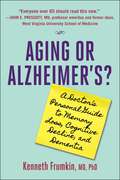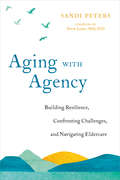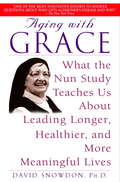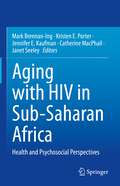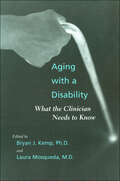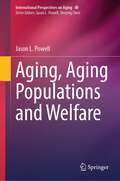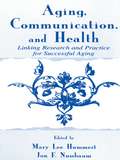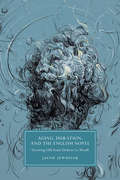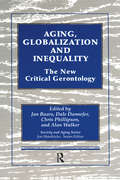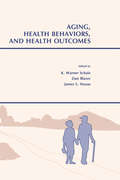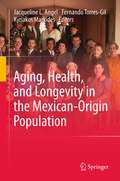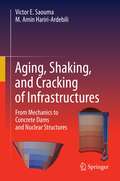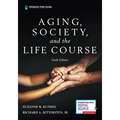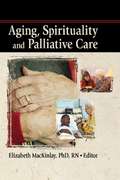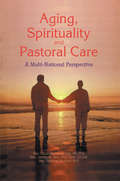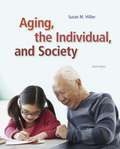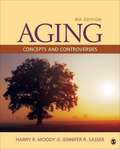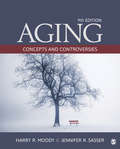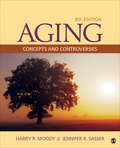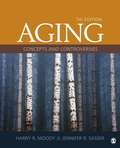- Table View
- List View
Aging or Alzheimer's?: A Doctor's Personal Guide to Memory Loss, Cognitive Decline, and Dementia
by Dr. Kenneth FrumkinIs it normal aging, Alzheimer&’s, or another dementia? Two of three Americans will experience cognitive impairment by the age of 70. But is it natural age-related forgetfulness, or the early indication of Alzheimer&’s Disease or other types of dementia? How worried should older people—or their families and friends—be about their memory loss? And what happens next? Kenneth Frumkin, PhD, MD, recently retired from a 36-year medical career and facing his own age- and memory-related challenges, provides an empathetic and comprehensive guide to answering those questions. Aging or Alzheimer's? explains what is currently known about the challenges to memory and cognition that come with longevity. Dr. Frumkin describes the progression of Alzheimer&’s Disease and other dementias; discusses when to see a doctor and what to expect from the visit; weighs the pros and cons of available tests, treatments, and research; shares personal and passionate tips for coping with decline; and gives the best ways to preserve cognitive health. There are an average of 15 new Alzheimer&’s publications per day. While busy practicing doctors often wait for the consensus reviews of new Alzheimer&’s studies that are published about every 10 years, Dr. Frumkin provides evidence-based, up-to-date guidance from the most current memory research. The result is your complete, modern guide to understanding and managing your—or your loved ones&’—memory loss or cognitive decline.
Aging with Agency: Building Resilience, Confronting Challenges, and Navigating Eldercare
by Sandi PetersAn experiential guide to re-orienting our understanding of late adulthood as one of life's most meaningful and transformative stagesAging can bring new fears, challenges, and concerns. Loss of career, loved ones, or changing physical and cognitive abilities can leave us feeling isolated and scared. Sandi Peters shows us that growing older need not mean the end of personal growth. In fact, late adulthood can prove to be the most meaningful and transformative period of one's life. The key, says Peters, is the development of one's inner life, and with it a shift in one's relation to the aging process. The book draws on history, philosophy, psychology, gerontology, and spirituality to deepen and expand our understanding of what it means to grow old in the twenty-first century. Peters shares time-tested contemplative practices such as meditation, active imagination, dream work, and creative writing designed to enhance one's inner worlds and enable us to face life's inevitable changes with equanimity and insight. She offers practical advice on issues such as assisted living and home care, and a refreshingly new perspective on matters of memory and cognitive change.
Aging with Grace - What the Nun Study Teaches Us About Leading Longer, Healthier, and More Meaningful Lives: What the Nun Study Teaches Us About Leading Longer, Healthier, and More Meaningful Lives
by David SnowdonIn 1986 Dr. David Snowdon, one of the world’s leading experts on Alzheimer’s disease, embarked on a revolutionary scientific study that would forever change the way we view aging—and ultimately living. Dubbed the “Nun Study” because it involves a unique population of 678 Catholic sisters, this remarkable long-term research project has made headlines worldwide with its provocative discoveries. Yet Aging with Grace is more than a groundbreaking health and science book. It is the inspiring human story of these remarkable women—ranging in age from 74 to 106—whose dedication to serving others may help all of us live longer and healthier lives. Totally accessible, with fascinating portraits of the nuns and the scientists who study them, Aging with Grace also offers a wealth of practical findings: • Why building linguistic ability in childhood may protect against Alzheimer’s • Which ordinary foods promote longevity and healthy brain function • Why preventing strokes and depression is key to avoiding Alzheimer’s • What role heredity plays, and why it’s never too late to start an exercise program • How attitude, faith, and community can add years to our lives A prescription for hope, Aging with Grace shows that old age doesn’t have to mean an inevitable slide into illness and disability; rather it can be a time of promise and productivity, intellectual and spiritual vigor—a time of true grace.
Aging with HIV in Sub-Saharan Africa: Health and Psychosocial Perspectives
by Catherine MacPhail Janet Seeley Mark Brennan-Ing Kristen E. Porter Jennifer E. KaufmanWith the development of effective antiretroviral therapies (ART) in the mid-1990s, HIV became a treatable although serious condition, and people who are adherent to HIV medications can attain normal or near-normal life expectancies. Because of the success of ART, people 50 and older now make up a majority of people with HIV in high-income countries and other places where ART is accessible. The aging of the HIV epidemic is a global trend that is also being observed in low- and middle-income countries, including countries in sub-Saharan Africa, where the greatest number of older people with HIV reside (3.7 million). While globally over half of older adults with HIV are in sub-Saharan Africa, we have little information about the circumstances, needs, and resiliencies of this population, which limits our ability to craft effective policy and programmatic responses to aging with HIV in this region. At present, our understanding of HIV and aging is dominated by information from the U.S. and Western Europe, where the epidemiology of HIV and the infrastructure to provide social care are markedly different than in sub-Saharan Africa. Aging with HIV in Sub-Saharan Africa addresses this gap in our knowledge by providing current research and perspectives on a range of health and psychosocial topics concerning these older adults from across this region. This volume provides a unique and timely overview of growing older with HIV in a sub-Saharan African context, covering such topics as epidemiology, health and functioning, and social support, as well as policy and program implications to support those growing older with HIV. There are very few published volumes that address HIV and aging, and this is the first book to consider HIV and aging in sub-Saharan Africa. Most publications in this area focus on HIV and aging in Uganda and South Africa. This volume broadens the scope with contributions from authors working in West Africa, Botswana, and Kenya. The range of topics covered here will be useful to professionals in a range of disciplines including psychology, epidemiology, gerontology, sociology, health care, public health, and social work.
Aging with a Disability: What the Clinician Needs to Know
by Ph. D. Laura Mosqueda Bryan J. KempWith advances in medical care, technology, and rehabilitation, people with disabilities are now living longer. Many, in fact, have near-average life expectancies. Research has shown, however, that the changes and problems associated with aging often occur 10–20 years earlier in the lives of people with disabilities than in the lives of people without disabilities. These changes pose significant challenges for health care professionals. Because research in this field is relatively recent, few practitioners and students are aware of these findings.Aging with a Disability provides clinicians with a complete guide to the care and treatment of persons aging with a disability. Divided into five parts, this book first addresses the perspective of the person with a disability and his or her family. Chapters in the second section address the physiological and functional changes people will face as they grow older, and how these changes may affect quality of life and caregiver requirements. In the third part, contributors discuss treatment considerations such as maintaining employment and managing pain and fatigue. The book's fourth section focuses on specific conditions: spinal cord injury, polio, cerebral palsy, and developmental disabilities such as mental retardation. In the concluding section, the authors present research needs and discuss policy issues for future consideration. Paying special attention to the feelings, attitudes, and needs of people with disabilities—three chapters are written by authors who have a disability—Aging with a Disability gives students and clinicians a reliable and compassionate handbook for the treatment of this growing population.
Aging, Aging Populations and Welfare (International Perspectives on Aging #40)
by Jason L. PowellAs the world experiences a rapid increase in the aging population, it is essential to address the challenges and opportunities that arise as a result. This book explores the significant impact of aging on individual well-being, societal welfare systems, and the global economy. By examining the multifaceted aspects of aging, demography and welfare, the book aims to provide a comprehensive and critical narrative to navigating these challenges and achieving better outcomes for both older individuals and society as a whole. The book has a critical approach running through it; despite this, there is a need to do something with the critical questions and focus on sustainable solutions to problems and issues an aging population poses to researchers, policy makers and older people themselves. In essence, the primary purpose of this book is to shed light on the complexities surrounding aging, demography and its intersection with welfare systems. By delving into various perspectives, such as social, economic, and healthcare considerations, this book highlights the holistic understanding needed to address the challenges associated with an aging population effectively.
Aging, Communication, and Health: Linking Research and Practice for Successful Aging (Routledge Communication Series)
by Jon F. Nussbaum Mary Lee HummertThis collection highlights the current efforts by scholars and researchers to understand the aging process as it relates to the health of older adults. With contributions from international scholars in communication, psychology, public health, medicine, nursing, and other areas, this volume emphasizes communication as a critical research, education, policy, and practice issue for the design, provision, and evaluation of health and social services for older adults. Organized into sections addressing communication developments in the healthcare arena, issues in provider-patient communication, and the relationships between family communication and health. The chapters cover critical topics related to successful aging, such as Alzheimer's disease, managed care and older adults, communication issues of severe dementia, and healthcare decision-making within families. The editors have designed this volume to be accessible to a broad audience, including scholars and students of aging and communication, healthcare practitioners with older clients, and aging individuals and their families who are pursuing strategies for successful aging. The chapters represent the highest levels of current scholarship on communication, aging, and health, providing a strong foundation for future research. Each contribution also addresses the applied implications of this research, offering practical guidance to readers dealing with these issues in their own lives. As a whole, Aging, Communication, and Health represents a major advance toward understanding the importance and application of communication for successful aging.
Aging, Duration, and the English Novel: Growing Old from Dickens to Woolf (Cambridge Studies in Nineteenth-Century Literature and Culture #120)
by Jacob JewusiakThe rapid onset of dementia after an illness, the development of gray hair after a traumatic loss, the sudden appearance of a wrinkle in the brow of a spurned lover. The realist novel uses these conventions to accelerate the process of aging into a descriptive moment, writing the passage of years on the body all at once. Aging, Duration, and the English Novel argues that the formal disappearance of aging from the novel parallels the ideological pressure to identify as being young by repressing the process of growing old. The construction of aging as a shameful event that should be hidden - to improve one's chances on the job market or secure a successful marriage - corresponds to the rise of the long novel, which draws upon the temporality of the body to map progress and decline onto the plots of nineteenth-century British modernity.
Aging, Functioning, and Rehabilitation: Proceedings of a Workshop
by Board on Health Care Services Board on Global Health National Academies of Sciences, Engineering, and Medicine Health and Medicine DivisionWith recent medical, technological, and socioeconomic developments, people are living longer. The rising average age of the world's population presents an opportunity to develop health policy that prioritizes functioning as a goal of healthy aging. In February 2024, the National Academies convened a hybrid workshop at the University of Lucerne in Switzerland to host a discussion focused on the World Health Organization's concept of functioning. Speakers paid particular focus to healthy aging and the future of rehabilitation as a health strategy. Experts emphasized that the need for rehabilitation is increasing due to rapid population aging accompanied by a rise in physical and mental health conditions, limitations, and injuries. The associated economic and practical obstacles of optimizing functioning across the life course were also discussed.
Aging, Globalization and Inequality: The New Critical Gerontology (Society and Aging Series)
by Jan Baars, Dale Dannefer Chris Phillipson, and Alan WalkerThis book is a major reassessment of work in the field of critical gerontology, providing a comprehensive survey of issues by a team of contributors drawn from Europe and North America. The book focuses on the variety of ways in which age and ageing are socially constructed, and the extent to which growing old is being transformed through processes associated with globalisation. The collection offers a range of alternative views and visions about the nature of social ageing, making a major contribution to theory-building within the discipline of gerontology. The different sections of the book give an overview of the key issues and concerns underlying the development of critical gerontology. These include: first, the impact of globalisation and of multinational organizations and agencies on the lives of older people; second, the factors contributing to the "social construction" of later life; and third, issues associated with diversity and inequality in old age, arising through the effects of cumulative advantage and disadvantage over the life course. These different themes are analysed using a variety of theoretical perspectives drawn from sociology, social policy, political science, and social anthropology. "Aging, Globalization and Inequality" brings together key contributors to critical perspectives on aging and is unique in the range of themes and concerns covered in a single volume. The study moves forward an important area of debate in studies of aging, and thus provides the basis for a new type of critical gerontology relevant to the twenty-first century.
Aging, Health Behaviors, and Health Outcomes (Social Structure and Aging Series)
by K. Warner Schaie Dan Blazer James S. HouseThis volume is the fourth in a series designed to facilitate inter-disciplinary communication between scientists concerned with the description of societal phenomena and those investigating adult development. As such, it contains a compilation of papers presented at an annual conference held at the Pennsylvania State University. These essays by sociologists and epidemiologists deal with the impact of disease and health outcomes with advancing age and are critiqued by members of related disciplines. In addition, there are overviews as well as specific discussions about the impact of cancer, depression, and cardiovascular diseases upon psychosocial functions.
Aging, Health, and Longevity in the Mexican-Origin Population (Social Disparities In Health And Health Care Ser.)
by Jacqueline L. Angel Fernando Torres-Gil Kyriakos MarkidesAging, Health, and Longevity in the Mexican-Origin Population creates a foundation for an interdisciplinary discussion of the trajectory of disability and long-term care for older people of Mexican-origin from a bi-national perspective. Although the literature on Latino elders in the United States is growing, few of these studies or publications offer the breadth and depth contained in this book.
Aging, Representation, and Thought: Gestalt and Feature-Intensive Processing
by Matthew SharpsThe brain contains many distinct functional and anatomical regions. Despite these differences, brain tissues are sufficiently uniform in the fact that they can engage in various types of processing. How can functionally different kinds of processes, such as verbal memory and reasoning, visual and auditory memory, and mental imagery, all be supported by the relatively uniform electrochemical activity of a brain's neurons? How are they appropriately segregated and integrated as needed? In Aging, Representation, and Thought, Matthew J. Sharps provides an empirically based, functional answer to what is, from the standpoint of modern cognitive psychology, a critical theoretical issue.Sharps argues that the crucial factor is the degree to which information is subjected to processing that is more gestalt or feature-intensive in nature. Sharps shows that purely gestalt processing deals with information in large "chunks," providing for relatively little incisive analysis. Purely feature-intensive processing, on the other hand, tends to ignore the overall nature and context of information in favor of comparatively minute analyses. It provides for relatively comprehensive analysis, but also for slow, cumbersome processing. Neither process, however, works in isolation, and Sharps demonstrates how information processing occurs on a continuum between the two extremes.Sharps' theoretical perspective is amply borne out by the results of specific experiments in all of the cognitive realms he addresses. He provides relatively comprehensive explanations for a variety of phenomena including the diminution of specific cognitive processes with age, and errors in eyewitness memory, reasoning, and decision-making at all levels of human activity. Aging, Representation, and Thought will be of interest to psychologists, students of adult development and aging, and management specialists.
Aging, Shaking, and Cracking of Infrastructures: From Mechanics to Concrete Dams and Nuclear Structures
by Victor E. Saouma M. Amin Hariri-ArdebiliThis self-contained book focuses on the safety assessment of existing structures subjected to multi-hazard scenarios through advanced numerical methods. Whereas the focus is on concrete dams and nuclear containment structures, the presented methodologies can also be applied to other large-scale ones.The authors explains how aging and shaking ultimately lead to cracking, and how these complexities are compounded by their random nature. Nonlinear (static and transient) finite element analysis is hence integrated with both earthquake engineering and probabilistic methods to ultimately derive capacity or fragility curves through a rigorous safety assessment.Expanding its focus beyond design aspects or the state of the practice (i.e., codes), this book is composed of seven sections:Fundamentals: theoretical coverage of solid mechnics, plasticity, fracture mechanics, creep, seismology, dynamic analysis, probability and statisticsDamage: that can affect concrete structures, such as cracking of concrete, AAR, chloride ingress, and rebar corrosion,Finite Element: formulation for both linear and nonlinear analysis including stress, heat and fracture mechanics,Engineering Models: for soil/fluid-structure interaction, uncertainty quantification, probablilistic and random finite element analysis, machine learning, performance based earthquake engineering, ground motion intensity measures, seismic hazard analysis, capacity/fragility functions and damage indeces,Applications to dams through potential failure mode analyses, risk-informed decision making, deterministic and probabilistic examples,Applications to nuclear structures through modeling issues, aging management programs, critical review of some analyses,Other applications and case studies: massive RC structures and bridges, detailed assessment of a nuclear containment structure evaluation for license renewal. This book should inspire students, professionals and most importantly regulators to rigorously apply the most up to date scientific methods in the safety assessment of large concrete structures.
Aging, Spirituality and Palliative Care
by Rev Elizabeth MackinleyGain greater depth of understanding of end-of-life spiritual issues for older adultsThe period of time when a person approaches death is always difficult both for the patient and the caregiver. Aging, Spirituality, and Palliative Care discusses best practices in aged and palliative care while addressing patients&’ diverse spiritual
Aging, Spirituality, and Pastoral Care: A Multi-National Perspective
by James W EllorHow can you foster spiritual growth in older people?This multidisciplinary work re-examines issues of aging with dignity and spiritual meaning. Aging, Spirituality, and Pastoral Care: A Multi-National Perspective brings together chaplains, pastors, counselors, and health care practitioners in all walks of gerontology from around the world to present a fully rounded picture of the spiritual needs and potentialities of this fast-growing population. It also includes a study of the spiritual awareness of nurses working in six different nursing homes, as well as a model for a parish nursing practice that focuses on the aged. Aging, Spirituality, and Pastoral Care addresses urgent issues for older people, including: social and spiritual isolation the wisdom of the aging the need for intimacy sexuality among older people living with dementia the spiritual dimensions of caregiving
Aging, the Individual, and Society
by Susan M. Hillier Georgia M. BarrowNo field of study more completely integrates the mature person over the life course than does gerontology. Understanding senior citizens-who represent a continually growing population-is becoming increasingly important. AGING, THE INDIVIDUAL, AND SOCIETY introduces readers to gerontology in a compassionate way that helps them understand older people and know how to work with them. The book balances academic research and practical discussions, integrating social and cultural perspectives with the story of the individual aging process. Activities and enhance reader's understanding and skills by providing many opportunities for experiential learning.
Aging: Concepts And Controversies
by Harry R. Moody Jennifer R. SasserPresenting current research in an innovative format, Harry Moody and Jennifer Sasser's Aging: Concepts and Controversies encourages students to become involved and take an informed stand on the major aging issues that we face as a society. Using their extensive expertise, the authors provide a thorough explanation of the issues in the Concepts sections and current research in the Controversy sections, demonstrating the close links between concepts and controversies in these broad areas of aging: health care, socioeconomic trends, and the life course.
Aging: Concepts and Controversies
by Harry R. Moody Jennifer R. SasserPresenting current research in an innovative text-reader format, Aging: Concepts and Controversies, Ninth Edition encourages students to become involved and take an informed stand on the major aging issues we face as a society. Not simply a summary of research literature, Harry R. Moody and Jennifer R. Sasser’s text focuses on controversies and questions, rather than on assimilating facts or arriving at a single "correct" view about aging and older people. Drawing on their extensive expertise, the authors first provide an overview of aging in three domains: aging over the life course, health care, and the socioeconomic aspects of aging. Each section is followed by a series of edited readings, offering different perspectives from experts and specialists on that subject. New readings focus on whether current federal spending on the elderly is sustainable and fair to other groups, how older consumers are reshaping the business landscape, and the challenges of marketing and selling to customers 60 and over. More emphasis is placed on how social class and inequality earlier in life can shape our final years and the number of older Americans living in poverty. The section on Aging and Health Care has been thoroughly updated to reflect the latest data about chronic diseases that affect the elderly, government spending on health care, and policy changes to programs like Medicaid and Medicare. The section on the Social and Economic Outlook for an Aging Society gives the most current picture of the racial and ethnic diversity of older Americans, their participation in the labor force, and their income and wealth.
Aging: Concepts and Controversies
by Harry R. Moody Jennifer R. SasserPresenting current research in an innovative text-reader format, Aging: Concepts and Controversies, Ninth Edition encourages students to become involved and take an informed stand on the major aging issues we face as a society. Not simply a summary of research literature, Harry R. Moody and Jennifer R. Sasser’s text focuses on controversies and questions, rather than on assimilating facts or arriving at a single "correct" view about aging and older people. Drawing on their extensive expertise, the authors first provide an overview of aging in three domains: aging over the life course, health care, and the socioeconomic aspects of aging. Each section is followed by a series of edited readings, offering different perspectives from experts and specialists on that subject. New readings focus on whether current federal spending on the elderly is sustainable and fair to other groups, how older consumers are reshaping the business landscape, and the challenges of marketing and selling to customers 60 and over. More emphasis is placed on how social class and inequality earlier in life can shape our final years and the number of older Americans living in poverty. The section on Aging and Health Care has been thoroughly updated to reflect the latest data about chronic diseases that affect the elderly, government spending on health care, and policy changes to programs like Medicaid and Medicare. The section on the Social and Economic Outlook for an Aging Society gives the most current picture of the racial and ethnic diversity of older Americans, their participation in the labor force, and their income and wealth.
Aging: Concepts and Controversies
by Harry R. Moody Jennifer R. SasserPresenting current research in an innovative format, Harry Moody and Jennifer Sasser&’s Aging: Concepts and Controversies encourages students to become involved and take an informed stand on the major aging issues that we face as a society. Using their extensive expertise, the authors provide a thorough explanation of the issues in the Concepts sections and current research in the Controversy sections, demonstrating the close links between concepts and controversies in these broad areas of aging: health care, socioeconomic trends, and the life course.
Aging: Concepts and Controversies (7th Edition)
by Harry R. Moody Jennifer R. SasserPresenting current research in an innovative format, Aging: Concepts and Controversies encourages students to become involved and take an informed stand on the major aging issues that we face as a society. Leading author and active expert in gerontology Rick Moody provides thorough explanation of the issues in the Concepts sections and current research in the Controversy sections, demonstrating the close link between concepts and controversies in these broad areas of aging: health care, socioeconomic trends, and the life course.
Aging: Concepts and Controversies (Columbia Studies Of Social Gerontology And Aging)
by Harry R. Moody Jennifer R. SasserAging: Concepts and Controversies is structured to encourage a style of teaching and learning that goes beyond conveying facts and methods. This innovative text focuses on controversies and questions rather than on assimilating facts or creating a single &“correct&” view about aging or older people. Drawing on their extensive expertise, authors Harry R. Moody and Jennifer R. Sasser first provide an overview of aging in three domains: aging over the life course, health care, and socioeconomic trends. Each section then includes data and conceptual frameworks, helping readers to make sense of the controversies and understand their origin, engage in critical thinking, and develop their own views. The Tenth Edition of this hallmark textbook includes amplified discussions focused on differences, diversity, structural inequalities, and inclusion, as well as contemporary issues, including climate change and immigration.
Aging: Concepts and Controversies (Columbia Studies Of Social Gerontology And Aging)
by Harry R. Moody Jennifer R. SasserAging: Concepts and Controversies is structured to encourage a style of teaching and learning that goes beyond conveying facts and methods. This innovative text focuses on controversies and questions rather than on assimilating facts or creating a single &“correct&” view about aging or older people. Drawing on their extensive expertise, authors Harry R. Moody and Jennifer R. Sasser first provide an overview of aging in three domains: aging over the life course, health care, and socioeconomic trends. Each section then includes data and conceptual frameworks, helping readers to make sense of the controversies and understand their origin, engage in critical thinking, and develop their own views. The Tenth Edition of this hallmark textbook includes amplified discussions focused on differences, diversity, structural inequalities, and inclusion, as well as contemporary issues, including climate change and immigration.
